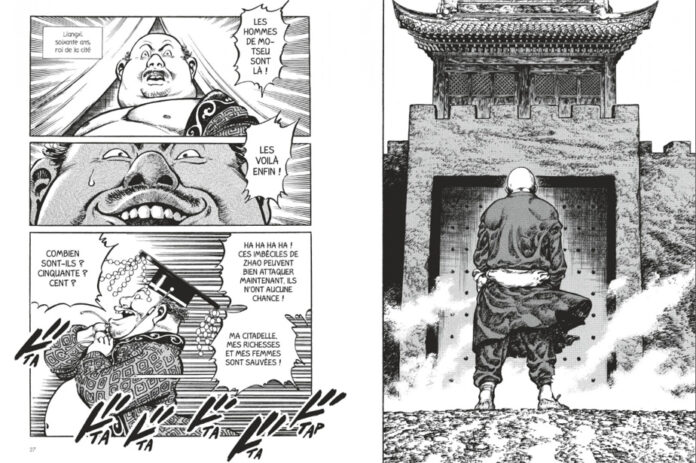Everyone (or almost) has read or heard of the famous treatise The Art of War by Sun-Tzu. But far fewer have heard of the writings of Mo-Tseu, an ancient Chinese philosopher, one of whose doctrines is based on the “art of peace” and interposition in the event of conflict. . At a time when the different lands that would later make up China were fragmented into belligerent kingdoms, his thought put itself at the service of the defense of nations, extending to an arm trained in martial arts intended to contain wars.
It is at the heart of this oriental painting that Bokko, a manga adapted from the novel of the same name published in 1991 in Japan, projects us. We discover there Ker-ri, a seemingly harmless man who has pledged allegiance to the principles of Mo-Tseu. Called for help by a small city on which an army of 15,000 soldiers is about to descend, this expert in military strategy will try to set up a defense tactic, while training the civilians threatened to face the assaults from a vastly outnumbered enemy. He who sows skepticism and transgresses social codes to achieve his ends shows cunning and experience; but will he be able to contain such an oppressive siege? Bokko goes much further than classic manga featuring armies on the battlefield, shedding light on this little-known philosophical movement in the service of a story where action and characters abound.
The drawing, on the other hand, is intended to be rather stripped down and centered on the protagonists, to the detriment of the decorations rendered to their simplest expression. If the drawing seems a bit aged (the original manga was published in Japan in 1992, this explaining that), the plot, its dynamism and its original approach to the theme of war make it a remarkable work, punctuated by very expressive full-page boards .
It is certainly not the first time that the great classic of Dumas has been triturated with Japanese sauce (a short series was published in 1987, and a single title in 2014), but this one has the particularity of being a derivative faithful to the film currently playing on the big screen. Boards and speech bubbles were entrusted to the Franco-Tunisian screenwriter Néjib and to the cartoonist passionate about history Cédric Tchao. On the ink side, finesse and dynamism are at the rendezvous for this very pleasant action manga. On the screenplay side, the adaptation proves to be a success: we find the exact plot of the film (d’Artagnan, an aspiring musketeer, crosses paths with the legendary trio, all of whom strive to fight against plots at court and the traps stretched by Cardinal Richelieu), embellished with the most striking replicas reproduced as is. Above all, the flashbacks and humor are in line with the manga style, which results in an entertaining rereading of the cinematic work. We suggest watching this one before tackling the manga, the disclosure will be less violent (experienced fact). The second volume will be released at the same time as the other part of the film, at the end of 2023.
On the side of the classic shonens, the lush and unbeatable One Piece series gave birth to a brief derivative collection, putting a spotlight on Ace, brother of the main hero Luffy. What is the background of this mysterious character, whose ambitions are no less excessive than those of his brother in the straw hat? In this first episode, we discover his meeting with Masked Deuce, who dreams of writing adventure stories, and the beginnings of the Spade crew, ready to follow Ace in his piracy challenges. Eiichirō Oda, author of the main series, certainly had far too much on his hands to embark on this crossroads.
The task of developing these A episodes was therefore entrusted to a pair, who based themselves on the adventures of the novel One Piece Novel A. The atmosphere and the touch of the original series of Oda are well restored, and its fans will undoubtedly find pleasure in getting their teeth into them while waiting for the new volumes of the flagship story – the French translation of volume 104 is also expected on June 21. Small problem: a small part of this first volume of Episodes A is devoted to a cover of volume 51 of the main series, an incongruous choice, when we would have taken a few additional pages from the adventures of Ace.
Abnormality become commonplace: While the wearing of face coverings that have upset our daily lives has now been considerably reduced, quite the opposite has happened in the society staged by this anticipation manga. Following a devastating pandemic (little detailed in the story), the mask has become an integral part of the general dress code. Even more: its systematization has given rise to an additional threshold of modesty, namely that exposing one’s mouth or seeing that of one’s neighbor has become as shameful as it is taboo. Traces of the old world where we walked with our lips exposed? Censored. In this context, Natsuki and Hata, two teenagers, will defy these new prohibitions and look into the lifestyles of the past. The idea supporting the manga is interesting, even if it is difficult to maintain the cohesion of the whole permanently. There is a “blue flower” side to the relationships between the characters, which orients it more towards a young audience with a soft and tender heart.















